

























Boeing B-50A "Superfortress"
United States — USAF four-engine medium bomber

Boeing B-50 Superfortress Overview
Boeing B-50A-5-BO Superfortress - Lucky Lady II (AF 46-010): First nonstop around-the-world flight: 26 February to 2 March 2 1949 (94 hrs 1 minute): Fuselage on display at the Planes of Fame Air Museum, Chino, CA (Photos by John Shupek)
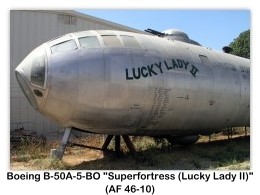
Boeing B-29A-40-BN "Superfortress" (AF 44-61669) at the March Field Air Museum, Riverside, CA (Photos by John Shupek)
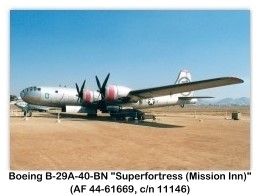

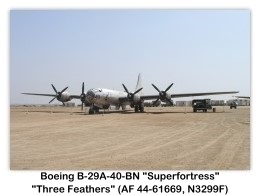

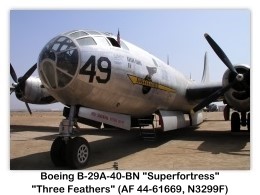


Boeing B-29A-35-BN "Superfortress" (AF 44-61535) at the Castle Air Museum, Atwater, CA (Photos by John Shupek)
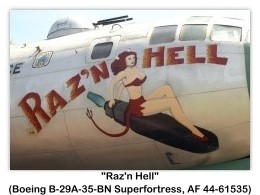
Design and Development
- Boeing B-50 "Superfortress"
- Role: Strategic bomber
- Manufacturer: Boeing
- First flight: 25 June 1947
- Introduced: 1948
- Retired: 1965
- Status: Retired
- Primary user: United States Air Force
- Produced: 1947-1953
- Number built: 371
- Unit cost: US $1,144,296
- Developed from: B-29 Superfortress
The B-50 program began life as the XB-44 Superfortress. One B-29A-5-BN (s/n 42-93845) was modified by Pratt & Whitney in 1944 to accept the larger engines; the resulting engine testbed first flew in May 1945. If the engine modification had been included in the B-29 program, the resulting model was to have been known as the B-29D. However, due to other structural changes that would also be necessary to address the increased power, weight and fuel consumption, it was decided to change its military designation to a new model. Since the B-44 program was only for the engine modification, that designation was not considered, and in December 1945 the program was named B-50 Superfortress. Officially, the aircraft’s new designation was justified by the changes incorporated into the revised aircraft, but according to Peter M. Bowers, a long-time Boeing employee and aircraft designer, and a well-known authority on Boeing aircraft, "the redesignation was an outright military ruse to win appropriations for the procurement of an airplane that by its designation appeared to be merely a later version of an existing model that was being canceled wholesale, with many existing examples being put into dead storage." Revisions to the Boeing B-50 (from its predecessor Boeing B-29) would result in a top speed just short of 400 mph (644 km/h), faster than many World War II propeller-powered fighters.
Changes included
- Larger engines
- Redesigned engine nacelles and engine mounts
- Enlarged vertical tail and rudder (to maintain adequate yaw control during engine-out conditions)
- Reinforced wing structure (required due to increased engine mass, larger gyroscopic forces from larger propeller, greater fuel load, and revised landing gear loading)
- Revised routing for engine gases (cooling, intake, exhaust and intercooler ducts; also oil lines)
- Upgraded fire-control equipment (to control remote turrets)
- Landing gear strengthening (takeoff weight increased from 133,500 lb/60,555 kg to 173,000 lb/78,471 kg)
- Increased fuel capacity (this was largely addressed by adding underwing fuel tanks).
- Revisions to flight control systems (the B-29 was already difficult to fly; with its increased weight the B-50 would have been much harder to hand-fly).
- Redesigned with a larger upper fuselage, the B-50 design would form the basis for the Boeing 377 series of airliners and C-97/KC-97 military transports, with 816 of the KC-97 built. The B-29 and B-50s would be phased out with introduction of the jet powered B-47 Stratojet. The B-50 was nicknamed "Andy Gump" because the redesigned engine nacelles reminded aircrew of the chinless newspaper comic character popular at the time.
Operational History
- Boeing built 371 of the various B-50 models and variants between 1947 and 1953, the tanker versions serving until 1965.
- A reconnaissance variant, the RB-50B (a B-50B conversion) played an important role in Cold War espionage.
- An aerial refueling tanker conversion designated KB-50 was used in the Vietnam War.
- In 1949, The Lucky Lady II, commanded by Captain James Gallagher, became the first airplane to circle the world nonstop. This was achieved by refueling the plane in flight.
- Although constructed in relatively small numbers, the B-50 was the last member of the B-29 family and was one of the last piston-engined bombers built. The B-50 was retired from its main role as atomic bomber in 1955. A number were converted into KB-50 tankers and lasted long enough to be deployed to Southeast Asia in support of tactical operations.
- B-50s were grounded and removed completely from inventory when wreckage of a KB-50 that broke up in flight in 1965 revealed corrosion problems in the fleet.
- No flying examples exist today, although several can be found in various air museums.
- The USAF Strategic Air Command had B-50 Superfortresses (B-50s and RB-50s) in service from 1948 through 1954.
Variants
- XB-44: One B-29A was handed over to Pratt & Whitney to be fitted with the new Wasp Major 28-cylinder engines. Initially designated B-29D, this was eventually changed to B-50A in December 1945. (× 1, converted)
- B-50A—First production version of the B-50. It had new wings that were stronger and lighter than the units on the B-29. It also had taller vertical tail than the B-29. (× 60)
- B-50B—Increase in gross weight over the A model, from 168,480 lb (76,420 kg) to 170,400 lb (77,290 kg). Also included a new type of lightweight fuel cell. (× 45)
- B-50D—Definitive production version of the B-50. The 7-piece nose cone window was replaced by a single plastic cone and a flat bomb-aimer’s window. Many included the new boom-type refueling system. (× 222)
- DB-50D—Drone director conversion of a B-50D, to be used with the GAM-63 RASCAL missile. (× 1, converted)
- EB-50B—Single conversion of a B-50B to be fitted with a track-tread undercarriage. (× 1, converted)
- KB-50—Air to air refueling tanker conversions of the bomber. (× 134, converted)
- KB-50J—Tanker B-50s with improved performance, via two extra General Electric J47 turbojets under the outer wings. (× 112, converted)
- KB-50K—Tanker conversions of the TB-50H trainer aircraft. (× 24, converted)
- RB-50B—All but one of the B-50Bs were converted into the recon role. These were fitted with nine cameras in four stations, weather instruments, and a bomb bay capsule holding the extra crew members. (× 44, converted)
- RB-50E—Special photographic conversions of the RB-50B, modified at Wichita. (× 14, converted)
- RB-50F—Conversions of the RB-50B, fitted with SHORAN navigation radar for special missions. (× 14, converted)
- RB-50G—Conversions of the RB-50B, fitted with electronics countermeasures stations along with the SHORAN radar. (× 15, converted)
- TB-50A—Trainer conversion of the B-50A. (× 11, converted)
- TB-50D—Trainer conversion of the B-50D. (× 11, converted)
- TB-50H—Newly built trainer planes. (× 24)
- WB-50 —Weather reconnaissance conversion of the B-50.
- WB-50D—Weather reconnaissance conversions of outdated B-50D’s, fitted with meteorological equipment. (× 36, converted). Some of these flew highly classified missions for atmospheric sampling between 1953 and 1955 to detect Soviet detonation of atomic weapons.[3]
- YB-50C—Version to be fitted with the Variable Discharge Turbine version of the R-4360 engine. None were built.
- B-54A—Proposed version of the YB-50C.
- RB-54A—Proposed reconnaissance version of the YB-50C.
Survivors
- Boeing B-50A-5-BO "Superfortress" (AF 46-0010) on display at the Planes Of Fame, Chino, California
- Boeing B-50D-115-BO "Superfortress" (AF 49-310) on display at the National Museum of the United States Air Force, Wright-Patterson AFB, Dayton, Ohio
- Boeing B-50D-120-BO "Superfortress" (AF 49-0351) on display at the Castle Air Museum, Castle Airport, Atwater, California
- Boeing B-50D-125-BO "Superfortress" (AF 49-0372) on display at the Pima Air and Space Museum, Tucson, Arizona
- Boeing B-50D-125-BO "Superfortress" (AF 49-0389) on display at MacDill AFB, Tampa, Florida
Operators
- United States: United States Air Force
Boeing B-50A Specifications
General Characteristics
- Crew: 8: Pilot, co-pilot, flight engineer, radio/electronic countermeasures operator, two side gunners, top gunner and tail gunner
- Length: 99 ft 0 in
- Wingspan:
- Height: 32 ft 8 in
- Wing area: 1,720 ft²
- Empty weight: 81,050 lb
- Loaded weight: 121,850 lb (55,270 kg)
- Max takeoff weight: 168,708 lb
- Powerplant: 4 × Pratt & Whitney R-4360-35 Wasp Major 28-cylinder, four-row air cooled radials with General Electric CH-7-B1 turbo-superchargers.
Performance
- Maximum speed: 385 mph @ 25,000 ft; 391 mph @ 30,000 ft
- Cruise speed: 235 mph
- Stalling speed: 136 mph
- Combat radius: 2,193 miles with 10,000 lb bombload
- Maximum range: 5,230 miles
- Service ceiling: 37,000 ft
- Initial climb rate: 2,225 ft/min
- Takeoff ground run: 5,940 ft at sea level
- Takeoff over 50-feet obstacle: 7,425 ft at sea level
- Wing loading: 70.19 lb/ft² (343 kg/m²)
- Power/mass: 0.115 hp/lb (193 W/kg)
Armament
- Guns: Four 0.50-inch machine guns in forward dorsal turret
- Guns: Two 0.50-inch machine guns in rear dorsal turret
- Guns: Two 0.50-inch machine guns in forward ventral turret
- Guns: Two 0.50-inch machine guns in rear ventral turret
- Guns: Two 0.50-inch machine guns and
- Guns: One 20-mm cannon in tail turret
- Maximum internal bombload: 20,000 lb
References
- Shupek, John. Photos, copyright © 2009 Skytamer Images. All Rights Reserved
- Wikipedia, the free encyclopedia. B-50 Superfortress, 8 December 2009
- Baugher, Joe. Boeing B-50A Superfortress., 8 December 2009









































































